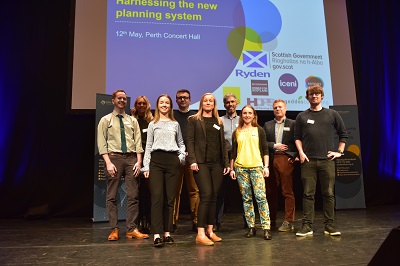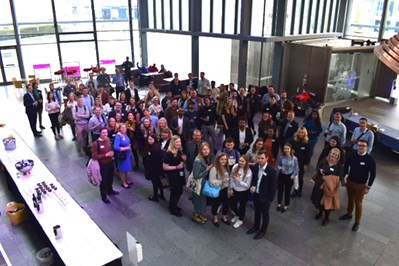Maximillian Steinberg, Scottish Young Planners’ Network Steering Group Committee Member, gives an overview of the 2022 Scottish Young Planners’ Conference
 The 2022 Scottish Young Planners Conference took place on 12 May at the Perth Concert Hall, and for many was the first in person event since the Covid-19 pandemic. The conference offered the opportunity for young planners across Scotland to explore Scotland’s response to the forthcoming National Planning Framework 4 (NPF4) and the new planning system. The four overarching themes of the conference were sustainable places, liveable places, productive places, and distinctive places as set out in the draft NPF4. The conference included a diverse range of speakers and provided an invaluable networking experience for young planners at the start of their careers.
The 2022 Scottish Young Planners Conference took place on 12 May at the Perth Concert Hall, and for many was the first in person event since the Covid-19 pandemic. The conference offered the opportunity for young planners across Scotland to explore Scotland’s response to the forthcoming National Planning Framework 4 (NPF4) and the new planning system. The four overarching themes of the conference were sustainable places, liveable places, productive places, and distinctive places as set out in the draft NPF4. The conference included a diverse range of speakers and provided an invaluable networking experience for young planners at the start of their careers.
The conference began with the Chief Planner for Scotland, Dr. Fiona Simpson, discussing a summary of her career along with some words from Tom Arthur MSP who highlighted planning’s “major influence on our lives, communities and future.” Fiona set out what is to come in Scottish planning, including the NPF4, Regional Spatial Strategies and digital innovation. She also explained the notable differences between planning at the start of her career in 1993 and today in 2022. Noteworthy comparisons included no jobs and office-based working in 1993 versus a skills shortage in 2022. Fiona provided inspiration for young planners at the start of their careers and highlighted that now is a great time to be a young planner.
Session 1 covered the concept of sustainable places and how Community Wealth Building, has been implemented in Scotland to support the delivery of a wellbeing economy. This was followed by Neil Collar explaining how human rights and planning can lead to the creation of sustainable places through a combination of statutory provisions. Delegates found this unique perspective particularly informative.
Session 2 covered the concept of liveable places where Pam Ewen discussed Infrastructure First through an examination of the policies, investment hierarchies, and plans which support it. Debbie Mackay then discussed how the development of rural areas needs to be considered within NPF4, Local Development Plans, Local Place Plans, and planning policy. Delegates left with an understanding of the importance of a rural perspective on planning during the initial stages of their careers.
Session 3 covered the concept of productive places where Paul Macari discussed the plans for the Industrial Green Transition Zone and provided a detailed example of the St Fergus carbon capture project in North East Scotland. Tommy Hart then presented an overview of SSEN’s planned network for net zero and highlighted the fundamental role of planning in meeting Scotland’s emissions reductions targets.
Up next, a soapbox session provided the opportunity for young planners at the very start of their careers to voice their ideas, giving much inspiration for the future of the Scottish planning system. Stephanie Fraser explained how planning is perceived currently and how the profile of planning can be improved. Petra Surplus then presented a review of the NPF4 from a student perspective and offered ideas to improve its user interactivity. Lastly, Aaron Doidge discussed the importance of social connectedness, quality of life, and wellbeing through public participation and community engagement in planning.
 Reflections from the day highlighted the practical skills delegates took away from the three workshop sessions. Dr. James White and Dr. Gareth James provided an overview of their study on the housing design quality conundrum across the four UK nations and highlighted the importance of design considerations in the planning process. Karen Hamilton provided an overview of the differences between public inquiries and hearings and then explained top tips for planners involved in the process. Neil Collar facilitated a discussion on developer obligations where topics included the differences between Section 69 and Section 75 agreements, affordable housing, and on-site provisions.
Reflections from the day highlighted the practical skills delegates took away from the three workshop sessions. Dr. James White and Dr. Gareth James provided an overview of their study on the housing design quality conundrum across the four UK nations and highlighted the importance of design considerations in the planning process. Karen Hamilton provided an overview of the differences between public inquiries and hearings and then explained top tips for planners involved in the process. Neil Collar facilitated a discussion on developer obligations where topics included the differences between Section 69 and Section 75 agreements, affordable housing, and on-site provisions.
Christina Gaiger finished with an inspiring keynote presentation on how to create distinctive places where she explored the concept of ‘distinctiveness’ as well as the “What if…? / Scotland” project, a multi-area study aimed to re-engage the civic role of architecture. One of Christina’s recommendations for young planners was to always ask the difficult questions and never be afraid to advocate for the unheard voices.
For many of the young planners, the conference was the first of their careers and the feedback from the day highlights the importance of face-to-face networking at this early stage in their working life. Delegates left feeling inspired and excited for the future having harnessed the new planning system which will influence the course of their careers. Reflecting on the conference, it is no doubt that planning in Scotland has a bright future ahead.


